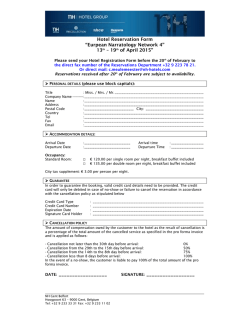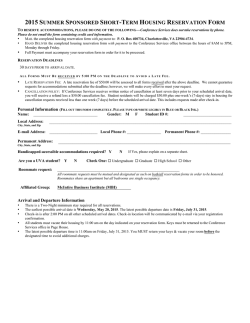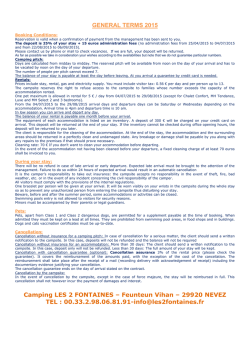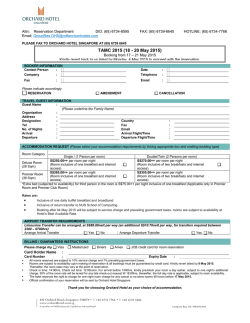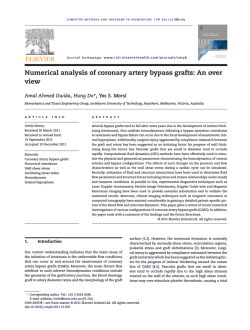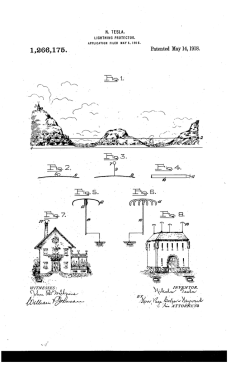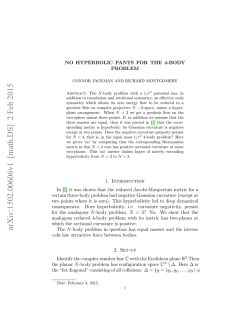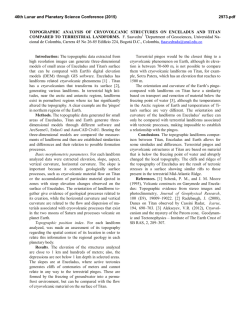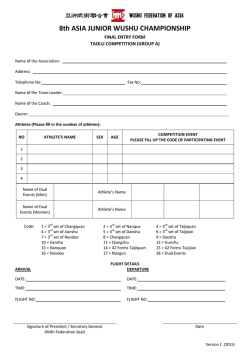
documento 504648
DIFFERENTIABILITY OF THE ARRIVAL TIME
arXiv:1501.07899v1 [math.DG] 30 Jan 2015
TOBIAS HOLCK COLDING AND WILLIAM P. MINICOZZI II
Abstract. For a monotonically advancing front (cf. [Se2]), the arrival time is the time
when the front reaches a given point. We show that it is twice differentiable everywhere
with uniformly bounded second derivative. It is smooth away from the critical points where
the equation is degenerate. We also show that the critical set has finite codimensional two
Hausdorff measure.
For a monotonically advancing front, the arrival time is equivalent to the level set method;
a priori not even differentiable but only satisfies the equation in the viscosity sense, [ChGG],
[ES1], [OsSe]. Using that it is twice differentiable and that we can identify the Hessian at
critical points, we show that it satisfies the equation in the classical sense.
The arrival time has a game theoretic interpretation. For the linear heat equation, this
relates to Black-Scholes option pricing.
From variations of the Sard and Lojasiewicz theorems, we relate differentiability to
whether or not singularities all occur at only finitely many times for flows.
0. Introduction
Let Mt ⊂ Rn+1 be a mean curvature flow (MCF) starting at a closed smooth mean convex
hypersurface M0 . Under the flow, Mt remains mean convex and, thus, moves monotonically
inward as it sweeps out1 the compact domain Ω0 bounded by M0 . The arrival time u : Ω0 →
R is the time when the front Mt arrives at a point x ∈ Ω0
(0.1)
u(x) = {t | x ∈ Mt } .
Even though M0 is smooth, the later Mt ’s need not be but are given by the level set method
and the function u is a priori only continuous.
Our main result is:
Theorem 0.2. The arrival time is twice differentiable everywhere, smooth away from the
critical set, and has uniformly bounded second derivative. Moreover,
• The critical set has finite codimensional two Hausdorff measure.2
• At each critical point the hessian is symmetric and has only two eigenvalues 0 and
− k1 ; 0 has multiplicity n − k (which could be 0) and − k1 has multiplicity k + 1. Here
k = 1, · · · , n.
• It satisfies the equation everywhere in the classical sense.
The authors were partially supported by NSF Grants DMS 11040934 and DMS 1206827.
1Each M bounds a compact domain Ω and Ω = ∪
t
t
t
s≥t Ms ; see Subsection 1.3.
2In fact, we get much more. For example, in R3 , the critical set is contained in finitely many (compact) embedded Lipschitz curves where the Hessian have eigenvalues 0 (with multiplicity 1) and −1 (with
multiplicity 2) together with a countable set where the Hessian is − 21 δi,j .
1
2
DIFFERENTIABILITY OF THE ARRIVAL TIME
A key point is that the second derivatives exist even at the critical set where the flow is
singular. Though it is known to be Lipschitz by a result of Evans and Spruck, [ES1], a priori
it is not even differentiable but only satisfies the second order degenerate equation in the
viscosity sense, [ChGG], [E1], [ES1]. In the convex case, where the flow is smooth except at
the point it becomes extinct, Huisken showed that the arrival time is C 2 in all dimensions,
[H2], [H3]. There is even more regularity in the plane, where Kohn and Serfaty showed,
using [GH], that it is at least C 3 , [KS1]. For n > 1, Sesum, [S], using [H3], showed that third
derivatives do not exist even for convex hypersurfaces. However, we will see in Theorem 4.1
that there is more regularity in the direction of the zero eigenvalues.
0.1. Level set method and viscosity solutions. The idea behind the level set method is
given an interface M0 in Rn+1 of codimension one, bounding a (perhaps multiply connected)
closed region Ω0 , one analyzes and computes its subsequent motion under a velocity field,
[OJK], [OsFe], [OsSe], [Se1], [Se3]. This velocity can depend on position, time, the geometry
of the interface (e.g. its normal or its mean curvature) and the external physics. The idea
is to define an at least continuous function v(x, t), that represents the interface as the set
where v(x, t) = 0. The level set function v has the following properties3
• v(x, t) > 0 for x ∈ Ωt \ ∂Ωt .
• v(x, t) < 0 for x ∈ Rn+1 \ Ωt .
• v(x, t) = 0 for x ∈ ∂Ωt = Mt .
This is of great significance for numerical computation and in applications, primarily because
topological changes such as breaking and merging are well defined. When all level sets evolve
by MCF, this motion becomes
∇v
vt = |∇v| div
(0.3)
,
|∇v|
and has been studied extensively. Whereas the work of Osher and Sethian was numerical,
Evans and Spruck, [ES1], and, independently, Chen, Giga, and Goto, [ChGG] provided the
theoretical justification for this approach. This is analytically subtle, principally because
the mean curvature evolution equation is nonlinear, degenerate, and indeed even undefined
at points where ∇v = 0. Moreover, v is a priori not even differentiable, let alone twice
differentiable. They resolved these problems by introducing an appropriate definition of a
weak solution, inspired by the notion of “viscosity solutions”; [Ca], [CrIL].
When the front is advancing monotonically (so the mean curvature is non-negative) Evans
and Spruck, [ES1], showed that v(x, t) = u(x) − t, where u is Lipschitz and satisfies (in the
viscosity sense; see Section 3 for details)
∇u
−1 = |∇u| div
(0.4)
.
|∇u|
Obviously, u−1 (t) is Mt ; in other words: u is the arrival time; see [Se2] for numerics.
0.2. Game theoretic intepretation. We will next briefly explain a game theoretical interpretation of the arrival time following, essentially verbatum, Kohn and Serfaty, [KS2], see
also [E2], [GL], [K], [KS1]–[KS3], [Sp]. For the linear heat equation, the arrival time relates
to Black-Scholes option pricing, see [KS2], [KS3].
3Strictly
speaking, the interface could have an interior; this does not occur in the case considered here.
DIFFERENTIABILITY OF THE ARRIVAL TIME
3
In a two-person game, with players Paul and Carol and a small parameter ǫ. Paul is
initially at some point x in a bounded domain Ω; his goal is to exit as soon as possible.
Carol wants to delay his exit as long as possible. The game proceeds as follows:
• Paul chooses a direction, i.e., a unit vector |v| = 1.
• Carol can either accept or reverse Paul’s choice, i.e., she chooses b = ±1.
• Paul then moves 2 ǫ in the possibly reversed direction, i.e., from x to x + 2 ǫ b v.
• This cycle repeats until Paul reaches ∂Ω.
Let uǫ be ǫ2 times the number of steps that Paul needs to exit. Can Paul exit? Yes indeed.
For Paul’s optimal strategy the time before exit limǫ→0 uǫ is exactly the arrival time.4
The Paul-Carol game was introduced in the 1970s by Joel Spencer, [Sp], as a heuristic for
the study of certain combinatorial problems.
0.3. Finitely many singular times. Differentiability is connected to the following wellknown conjecture; [AAG], page 533 of [W1], conjectures 0.5 in [CM4] and 6.5 in [CMP]:5
Conjecture 0.5. For Mt as above, the evolving hypersurface is completely smooth except
at finitely many times.6
The connection is that the regularity of a function u controls the size of the set C of critical
values. In dimension three, if u : Ω ⊂ R3 → R is at least C 3 , then C has measure zero by
Sard’s theorem, see, e.g., [Y]. Moreover, if u is C k for some k > 3, then C has dimension
at most k3 < 1. Similarly, in higher dimensions. The arrival time is only twice differentiable
which does not seem like enough to get measure zero from Sard’s theorem. However, using
[CM4], we will see that the critical set is contained in a finite union of compact curves plus
countably many points and, thus, Sard’s theorem on the line suggests that C has dimension
at most 21 . This heuristic argument uses the structure established in [CM4], where the bound
1
for the dimension was rigorously shown by a different argument.
2
When the arrival time is real analytic, there can be only finitely many singular times. To
see this, recall the gradient Lojasiewicz inequality, [L], [CM2], [CM3]:
A function u is said to satisfy the gradient Lojasiewicz inequality if for every
p ∈ Ω, there is a possibly smaller neighborhood W of p and constants β ∈
(0, 1) and C > 0 such that |u(x) − u(p)|β ≤ C |∇x u| for all x ∈ W .
Lojasiewicz proved this inequality for analytic functions and, thus, a critical point has a
neighborhood with no other critical values. Consequently, C is finite if Ω is compact:
Corollary 0.6. There are only finitely many singular times if the arrival time is real analytic.
For mean convex MCF the Lojasiewicz inequality would say (since H |∇u| = 1 by (1.4))
that for p ∈ Ω, there is a neighborhood W of p and constants β ∈ (0, 1), C > 0 such that
H(x) |t(x) − t(p)|β ≤ C for all x ∈ W . Since |A|2 ≤ C H 2 for a mean convex MCF by the
parabolic maximum principle for C depending on M0 , the Lojasiewicz inequality would say
(0.7)
4[KS1]
|A(x)| |t(x) − t(p)|β ≤ C .
needed that the arrival time is C 3 to prove that limǫ→0 uǫ exists and is the arrival time.
It is interesting to compare with a series of papers by Bamler, [Ba], on the long-time behavior of Ricci
flows with surgery. He shows that only finitely many surgeries occur if the surgeries are performed correctly.
6In low dimensions it is known by [CM4] that connected components of the singular set are contained in
time-slices and almost all time slices are completely smooth.
5
4
DIFFERENTIABILITY OF THE ARRIVAL TIME
In other words, |A| blows-up at a singular point at most like |t−t0 |−β , where t0 is the singular
1
time. By a standard ODE comparison argument, it blows up at least like |t − t0 |− 2 . If |A|
1
blows-up at a rate of at most |t − t0 |− 2 , then the singularity is said to be type one.
1. Preliminary estimates
1.1. Mean convex MCF. We have already seen that the level set method is equivalent to
the arrival time function for a monotonically advancing front. Namely, v(x, t) = u(x) − t by
Subsection 0.1. Since we will use the equation for u (i.e., (0.4)) several times we will deduce
it for completeness. Suppose therefore that Mt ⊂ Rn+1 is a mean convex MCF and u = t.
As we will explain in Section 3 the equation for u is initially interpreted in classical sense at
points where ∇u 6= 0 and in the barrier, or viscosity sense, everywhere else. For the sake of
deducing the equation assume we are at a point where ∇u 6= 0 and u is smooth, then
∇u
∇u
divMt
(1.1)
= −xt .
|∇u| |∇u|
Since u(x(t)) = t, we have that h∇u, xt i = 1, or, equivalently,
(1.2)
xt =
1 ∇u
∇u
=
.
|∇u| |∇u|
|∇u|2
Putting this together gives
∇u
∇u
∇u ∇u
(1.3) −1 = |∇u| divMt
= |∇u| div
= ∆ u − Hessu
= ∆1 u ;
,
|∇u|
|∇u|
|∇u| |∇u|
where ∆1 is the 1-Laplacian.7 The operator ∆1 is the trace of the Hessian over the ndimensional subspace orthogonal to ∇u. It is nonlinear and degenerate
elliptic. The ordinary
∇u
∇u
Laplacian ∆ is the sum of ∆1 and the ∞-Laplacian ∆∞ u = Hessu |∇u|
. The mean
, |∇u|
curvature H (with respect to the outward unit normal of Ωt ) is
H = |∇u|−1 .
(1.4)
cylinder Sk × Rn−k in Rn+1 with radius
√ As an example, consider the shrinking round √
−2kt for t < 0 so that at time −1 the radius is 2k and it becomes extinct at time 0. In
1
this case, u = − 2k
x21 + · · · + x2k+1 is analytic and the critical set is {0} × Rn−k .
1.2. C 1,1 estimates away from the singular set.
Lemma 1.5. There is a constant C1,1 depending on the initial hypersurface so that
(1.6) |Hessu | ≤ C1,1 on the regular set (the complement of the singular set for the flow) .
In contrast, the derivatives of the hessian are not uniformly bounded in general, [S]. To
prove the lemma, we need that, by a result of Haslhofer-Kleiner, [HaK]8, for each integer
ℓ ≥ 0, there is a C (depending on M0 and ℓ) so that
ℓ ∇ A ≤ C H ℓ+1 .
(1.7)
7It
is more common to define the 1-Laplacian as div
8This
applies by Andrews, [An], [AnLM].
∇u
|∇u|
which differs by a factor of |∇u|; cf. [E2].
DIFFERENTIABILITY OF THE ARRIVAL TIME
5
Proof of Lemma 1.5. We will consider three cases for the various components of the Hessian.
Since H = |∇u|−1 and, given unit vectors ei and ej tangent to the level set, we have
(1.8)
A(ei , ej ) =
Hessu (ei , ej )
= H Hessu (ei , ej ) ,
|∇u|
|A(e ,e )|
i j
it follows that |Hessu (ei , ej )| =
is uniformly bounded by the case ℓ = 0 of (1.7).
H
∇u
For the double normal direction, use that |∇u| = H −1 and xt = |∇u|
2 = H n so that
1
∂t H
∆H |A|2
∂t H −1 = 3 = 3 + 2 ,
H
H
H
H
where the last equality is Simons’ equation for H. We have already bounded the last term
term is bounded by the case ℓ = 2 of (1.7).
and the remaining ∆H
H3
Similarly, the hessian in a mixed tangential/normal direction is given by
Hi
(1.10)
Hessu (ei , n) = ∇ei |∇u| = ∇ei H −1 = − 2 .
H
This term is bounded by the case ℓ = 1 of (1.7), completing the proof.
(1.9)
−Hessu (n, n) = −∇n |∇u| = −
1.3. Level set flow. Up until now, we have worked solely on the regular set for the flow
where the solution u is smooth and ∇u 6= 0. We will now work across the singularities.
We begin by recalling the properties of mean convex MCF starting from a smooth closed
mean convex hypersurface:
(1) There is a unique Lipschitz function u giving a viscosity solution of the level set flow.
(2) The flow is non-fattening (i.e., the level sets have no interior), each level set is the
boundary of a compact mean convex set, and u is defined everywhere on the interior.
(3) The level sets define a Brakke flow of integral varifolds.
(4) Each tangent flow at a singularity is a multiplicity one (generalized) cylinder.
(5) On the regular set for the flow, the function u is smooth and ∇u 6= 0.
Claim (1) is theorem 7.4 in [ES1]; cf. [ChGG]. Claim (2) follows from theorems 3.1 and 3.2
and corollary 3.3 in [W2]. Claim (3) is theorem 5.1 in [W2]; cf. [ES2], [MS]. For Claim (4),
see theorem 3 in [W4] (cf. [HS]). The last claim is almost a tautology. If the flow is smooth
in a neighborhood, we can write it as a normal graph (x, t) → x + v(x, t) n(x) of a smooth
function v(x, t) defined on the level set with v(x, 0) = 0. The map is smoothly invertible and
u is the t component of the inverse. Invertibility follows from the inverse function theorem
since the differential of this map has full rank since H does not vanish. Finally, ∇u does not
vanish on the regular part because H = |∇u|−1 .
1.4. Hausdorff measure of the critical set. To prove the desired bound for the Hausdorff
measure, consider the forgetful map Φ : (x, t) → x from Rn+1 ×R to Rn+1 . On the domain we
use the parabolic k-dimensional Hausdorff measure9 and on the target we use the ordinary kdimensional Hausdorff measure. Since the forgetful map is distance non-increasing, it follows
that Hk (A) ≤ HP k (A) . Applying this to the space-time singular set S and using (5) gives
(1.11)
9This
Hn−1 ({x ∈ Rn+1 | ∇x u = 0}) ≤ Hn−1 (Φ(S)) ≤ HP n−1 (S) < ∞ ,
is the k-dimensional Hausdorff measure associated to the parabolic distance distP on Rn+1 × R
1
given by distP ((x, s), (y, t)) = max{|x − y|, |s − t| 2 }; see subsection 1.1 of [CM4].
6
DIFFERENTIABILITY OF THE ARRIVAL TIME
where the last inequality HP n−1 (S) < ∞ is proven in [CM4] (cf. footnote 1).
1.5. The singular set equals the critical set.
Corollary 1.12. u is C 1,1 and the singular set is equal to the critical set {∇u = 0}.
We will need the following standard extension:
Lemma 1.13. Suppose that Ω ⊂ Rn+1 is a connected open set with smooth closure and
S ⊂ Ω is closed and has codimension two. If f : Ω \ S → R is smooth with |f | + |∇f | ≤ C,
then f can be extended continuously to Ω and the extension is Lipschitz.
Proof. Given points x, y ∈ Ω \ S, we can find a C 1 path γ from x to y whose length is at
most twice the distance (in Ω) from x to y and that avoids S since S has codimension two.
Applying the fundamental theorem of calculus along this path, the bound on ∇f gives
(1.14)
|f (x) − f (y)| ≤ 2 C distΩ (x, y) .
Since x and y were arbitrary, f is uniformly Lipschitz on Ω. It follows that f has a unique
continuous extension to all of Ω and that this extension is Lipschitz with the same bound. Proof of Corollary 1.12. We will first see that each partial derivative uk is continuous on the
entire domain Ω. Let S be the singular set, so that it is closed, by definition, and has finite
codimension two measure by [CM4]. The function uk is smooth on Ω \ S and has uniformly
bounded ∇uk as well by Lemma 1.5. We can therefore apply Lemma 1.13 to see that uk is
defined on all of Ω and is Lipschitz.
To see that ∇u vanishes on the singular set, note that each singularity has a cylindrical
tangent flow and, thus, is given as a limit of regular points with H = |∇u|−1 going to infinity.
Since |∇u| is continuous, we must have |∇u| = 0 at the singular point.
2. The second derivatives at critical points
We now prove the existence of the second derivatives at a critical point and show that
the Hessian is given by the tangent flow at the singularity. This depends crucially on the
uniqueness of the tangent flow proven in [CM2].
To keep the notation simple, we will assume that 0 is a critical point of u and u(0) = 0.
By [CM2], there is a unique tangent flow at 0 which is a multiplicity one cylinder. After a
rotation, the level set flow corresponding to the blow up cylinder is given by the function
(2.1)
w=−
k+1
1 X 2
x ,
2k i=1 i
and ∇w = − xk+ , where x+ = (x1 , . . . , xk+1 , 0, . . . , 0) is the projection of x onto Rk+1 .
Proposition 2.2. The function u is twice differentiable at 0 and Hessu = Hessw at 0.
To understand this, rescale the flow by a factor α > 0 so that the new arrival time becomes
(2.3)
uα (x) = α−2 u(αx) .
This rescaling preserves the Hessian at 0 (assuming it exists) and, as α goes to 0, the rescaling
converges (in a sense to be made precise) to the tangent flow at 0.
DIFFERENTIABILITY OF THE ARRIVAL TIME
7
We will prove that the difference quotients of ∇u have a limit. We will consider two cases,
depending on how the points approach 0. The main case is the following:
Lemma 2.4. If xi is any sequence in Rn+1 with u(xi ) < 0, xi → 0,
lim sup
(2.5)
i→∞
then
i)
limi→∞ ∇u(x
|xi |
|xi |2
< ∞,
|u(xi )|
xi
|xi |
→ v, and
exists and is equal to ∂v ∇w.
Proof. Since u(xi ) < 0 and xi → 0, [CM2] implies that the rescaled level sets
(2.6)
{u = u(xi )}
p
−u(xi )
converge smoothly on compact sets to the cylinder Σk = {x21 + · · · + x2k+1 = 2k} ⊂ Rn+1 .
The condition (2.5) implies that the points
xi
yi ≡ p
(2.7)
−u(xi )
lie in a bounded set. Choose a subsequence (still denoted by yi ) that converges to a limiting
point y ∈ Rn+1 . Write y as y = (y+ , y− ), where y+ ∈ Sk√2k is the projection of y on the first
k + 1 coordinates and y− ∈ Rn−k is the orthogonal part. At yi , the normal to the rescaled
level set and the mean curvature are given by
p
−u(xi )
∇u(xi )
(2.8)
and
.
|∇u(xi )|
|∇u(xi )|
Since these are converging to the same quantities for the limit Σk at y, we see that
p
√
−u(xi )
−y+
∇u(xi )
k
→√
→ √ .
and
(2.9)
|∇u(xi )|
|∇u(xi )|
2
2k
Combining (2.7) with the two previous limits, we see that
!−1
p
−u(xi )
∇u(xi )
−v+
−y+
∇u(xi )
(2.10)
=
=
,
|yi |−1 →
|xi |
|∇u(xi )|
|∇u(xi )|
k |y|
k
where the last equality used that |xxii | → v and v+ is the projection of v onto Rk+1.
This limit is independent of the choice of subsequence and, thus, the limit of the difference
quotients exists and is given by (2.10). Finally, we observe that this is equal to ∂v ∇w.
The previous lemma gives the Hessian, but requires that we approach 0 in a direction
where u < 0. By the next lemma, this covers every direction except along the axis.
Lemma 2.11. Given ǫ > 0, there exist C, δ > 0 so that if x = (x+ , x− ) ∈ Rk+1 × Rn−k has
(2.12)
then |x|2 ≤ −C u(x).
|x+ | ≥ ǫ |x− | and |x| ≤ δ ,
Proof. This follows from the uniqueness of [CM2].
8
DIFFERENTIABILITY OF THE ARRIVAL TIME
Proof of Proposition 2.2. Fix a unit vector v = (v+ , v− ) and let δi > 0 be a sequence converging to 0. We will consider two cases.
Suppose first that |v+ | > 0. Lemma 2.11 implies that the sequence xi ≡ δi v (for i large
enough) satisfies the hypotheses of Lemma 2.4. Therefore, we conclude that
−v+
∇u(δi v)
=
= ∂v ∇w .
i→∞
δi
k
Suppose next that v+ = 0. Given some small ǫ > 0, Lemma 2.11 implies that the sequence
(2.13)
lim
(2.14)
xi ≡ δi v + (ǫ δi , 0, . . . , 0)
satisfies the hypotheses of Lemma 2.4 (for i large enough). Therefore, we conclude that
lim
(2.15)
i→∞
∇u(xi )
−(ǫ, 0, . . . , 0)
√
.
=
δi
k 1+ǫ
To relate this to the difference quotients in the direction v, use the C 1,1 bound to get
∇u(xi ) ∇u(δi v) |∇u(xi ) − ∇u(δi v)|
≤
(2.16)
≤ C ǫ.
δi −
δi
δi
Since ǫ > 0 is arbitrary, combining (2.15) and (2.16) gives
(2.17)
lim
i→∞
∇u(δi v)
= 0 = ∂v ∇w ,
δi
completing the proof.
3. Solving the equation classically
Evans and Spruck (section 7.3 in [ES1]; cf. [ChGG]) constructed a continuous viscosity
solution u of (1.3) and showed that it is unique and Lipschitz. Recall that u is a viscosity
solution if it is both a sub and super solution. A continuous function u is a sub solution
(super solutions are defined similarly) provided that:
If φ is a smooth functionso that u− φ has a local maximum at x0 , then
∇φ
∇φ
(1) ∆1 φ ≡ ∆ φ − Hessφ |∇φ|
≥ −1 at x0 if ∇φ(x0 ) 6= 0.
, |∇φ|
(2) ∆ φ − Hessφ (v, v) ≥ −1 at x0 for some vector |v| ≤ 1 if ∇φ(x0 ) = 0.
We will say that a twice differentiable function u is a classical solution of (1.3) if:
∇u
∇u
= −1 where ∇u 6= 0.
, |∇u|
(A) ∆1 u ≡ ∆ u − Hessu |∇u|
(B) ∆ u − Hessu (v, v) = −1 at x0 for some vector |v| = 1 if ∇u(x0 ) = 0.
Lemma 3.1. If w solves (1.3) classically, then w is also a viscosity solution.
Proof. We must show that w is both a sub and super solution. To see that w is a sub
solution, suppose that φ is smooth and w − φ has a local maximum at an interior point x0 .
By the first derivative test,
(3.2)
∇w(x0 ) = ∇φ(x0 ) .
The second derivative test for twice differentiable functions (11 on page 115 of [R]) gives
(3.3)
Hessw (v, v) ≤ Hessφ (v, v) at x0 for any vector v ∈ Rn+1 .
DIFFERENTIABILITY OF THE ARRIVAL TIME
9
If ∇φ 6= 0, then (3.2) implies that we are taking traces over the same n-dimensional subspaces
in (1) and (A); the inequality (3.3) then gives that (A) implies (1). In the other case where
∇φ = 0, then let v be the same unit vector in (1) as in (B). Taking the trace over v ⊥ , we
see that (B) and (3.3) imply (2). We conclude that w is a sub solution. The proof that w is
a super solution follows similarly.
The next lemma shows that spheres and cylinders give classical solutions to (1.3).
Pk+1 2
1
Lemma 3.4. If ∇u(0) = 0 and Hessu exists at 0 and equals Hessw where w = − 2k
i=1 xi ,
then u is a classical solution to (1.3) at 0.
Proof. If k = n (the spherical case), then Hessu (0) is diagonal with all n + 1 eigenvalues
equal to − n1 . In this case, (B) holds at 0 for any unit vector v.
When k < n, then Hessu (0) has k + 1 eigenvalues equal to − k1 and n − k zero eigenvalues.
In this case, (B) holds at 0 for any unit vector v in the − k1 eigenspace.
We get the following immediate consequence of Proposition 2.2 and Lemma 3.4:
Corollary 3.5. The viscosity solution is a classical solution.
Proof. By Corollary 1.12, the only thing to check is on the critical set. However, Proposition
2.2 gives the Hessian there and this satisfies (B) by Lemma 3.4.
This completes the proof of Theorem 0.2.
4. Vanishing order along the axis
The next theorem shows that ∇u vanishes faster than linearly in the direction of the axis
for a cylindrical singularity Sk × Rn−k (the Rn−k factor is the “axis”).
Theorem 4.1. If u has a cylindrical singularity at 0 and v is any unit vector in the direction
of the axis, then for some α > 0
(4.2)
lim
δ→0
(log | log δ|)α |∇u(δ v)|
= 0.
δ
Proof. Given a vector w, let w+ be the projection onto Rk+1 and w− be the projection onto
Rn−k , so v+ = 0 since v points in the direction of the axis.
Let Σs for s ≥ 0 be the rescaled MCF associated to the blowup at 0 given by
1
(4.3)
Σs ≡ √ {u = t} where t = −e−s .
−t
The uniqueness of [CM2]10 gives C so that Σs is a graph over Sk√2k × Rn−k in the ball B √log s
C
√
√
s
1
log
s
for
s
large.
with radius log
and
center
0
of
a
function
with
C
norm
at
most
C/
C
Using (4.3) to translate this to the original flow, we get graphical control on the Mt ’s when
(4.4)
10See
there.
|x|2 ≤ −C ′ t log | log −t| .
theorem 0.2 and footnote 6 in [CM2]. The precise rate follows from theorem 6.9 and lemma 6.1
10
DIFFERENTIABILITY OF THE ARRIVAL TIME
Suppose that δi is a sequence going to 0. Given any β ∈ (0, 1), the convergence in the
growing scale-invariant region (4.4) gives points yi (for i large) in the graphs with
(4.5)
δi2
.
(yi − δi v)− = 0 and |u(yi )| ≤
(log | log δi |)β
Since we are in the graphical region, we have
√
√
p
|(yi )+ | ≤ −u(yi )( 2k + 1) ≤ ( 2k + 1)
(4.6)
δi
.
(log | log δi |)β/2
If uc was the arrival time for the cylinder itself, we would have ∇uc (yi ) = − (yik)+ . Since yi is
in the graphical region, (4.6) implies that
(4.7)
C
|∇u(yi )|
≤
.
δi
(log | log δi |)β/2
The theorem follows (for any α < β/2) from this and using the C 1,1 bound on u to get
(4.8)
|∇u(yi ) − ∇u(δi v)| ≤ C |yi − δi v| = C |(yi )+ | .
References
[AAG] S. Altschuler, S.B. Angenent, and Y. Giga, Mean curvature flow through singularities for surfaces of
rotation, The Journal of Geometric Analysis (1995), Volume 5, Issue 3, 293–358.
[An] B. Andrews, Noncollapsing in mean-convex mean curvature flow . G&T 16 (2012), no. 3, 1413–1418.
[AnLM] B. Andrews, M. Langford, and J. McCoy, Convexity estimates for hypersurfaces moving by convex
curvature functions. Anal. PDE 7 (2014), no. 2, 407–433.
[Ba] R. Bamler, Long-time behavior of 3 dimensional Ricci flow – Introduction, preprint.
[Ca] E. Calabi, An extension of E. Hopf ’s maximum principle with an application to Riemannian geometry.
Duke Math. J. 25 (1958), 45–56.
[ChGG] Y.G. Chen, Y. Giga, and S. Goto, Uniqueness and existence of viscosity solutions of generalized
mean curvature flow equations. J. Differential Geom. 33 (1991), no. 3, 749–786.
[CM1] T.H. Colding and W.P. Minicozzi II, Generic mean curvature flow I; generic singularities, Annals of
Math., Volume 175 (2012), Issue 2, 755–833.
[CM2]
, Uniqueness of blowups and Lojasiewicz inequalities, Annals of Math., to appear.
[CM3]
, Lojasiewicz inequalities and applications, preprint.
[CM4]
, The singular set of mean curvature flow with generic singularities, preprint.
[CMP] T.H. Colding, W.P. Minicozzi II and E.K. Pedersen, Mean curvature flow , Bulletin of the AMS, to
appear, http://arXiv:1208.5988.
[CrIL] M.G. Crandall, H. Ishii, and P.L. Lions, User’s guide to viscosity solutions of second order partial
differential equations. Bull. Amer. Math. Soc. (N.S.) 27 (1992), no. 1, 1–67.
[E1] L.C. Evans, Regularity for fully nonlinear elliptic equations and motion by mean curvature. Viscosity
solutions and applications, 98–133, Lecture Notes in Math., 1660, Springer, Berlin, 1997.
, The 1-Laplacian, the ∞-Laplacian and differential games. In Perspectives in nonlinear partial
[E2]
differential equations, vol. 446 of Contemp. Math., 245–254. AMS, Providence, RI, 2007.
[ES1] L.C. Evans and J. Spruck, Motion of level sets by mean curvature I, JDG 33 (1991) 635–681.
, Motion of level sets by mean curvature IV. J. Geom. Anal. 5 (1995) 77–114.
[ES2]
[GH] M. Gage and R. Hamilton, The heat equation shrinking convex plane curves, JDG 23 (1986), 69-96.
[GL] Y. Giga and Q. Liu, A billiard-based game interpretation of the Neumann problem for the curve shortening equation. Adv. Differential Equations 14 (2009), no. 3–4, 201–240.
[HaK] R. Haslhofer and B. Kleiner, Mean curvature flow of mean convex hypersurfaces, preprint.
DIFFERENTIABILITY OF THE ARRIVAL TIME
11
[H1] G. Huisken, Asymptotic behavior for singularities of the mean curvature flow. JDG 31 (1990), no. 1,
285–299.
, Local and global behaviour of hypersurfaces moving by mean curvature. Differential geometry:
[H2]
partial differential equations on manifolds (Los Angeles, CA, 1990), 175–191, Proc. Sympos. Pure Math.,
54, Part 1, Amer. Math. Soc., Providence, RI, 1993.
, Flow by mean curvature of convex surfaces into spheres, JDG 20 (1984) 237–266.
[H3]
[HS] G. Huisken and C. Sinestrari, Mean curvature flow singularities for mean convex surfaces, Calc. Var.
Partial Differ. Equ. 8 (1999), 1–14.
[K] R.V. Kohn, Parabolic PDEs and Deterministic Games, SIAM News, Vol. 40, no. 8, 2007.
[KS1] R.V. Kohn and S. Serfaty, A deterministic control based approach to motion by curvature. CPAM. 59
(2006), no. 3, 344–407.
[KS2]
, Second-order PDE’s and deterministic games. ICIAM 07–6th International Congress on Industrial and Applied Mathematics, 239–249, Eur. Math. Soc., Z¨
urich, 2009.
, A deterministic-control-based approach to fully nonlinear parabolic and elliptic equations,
[KS3]
CPAM 63 (2010), no. 10, 1298–1350.
[L] S. Lojasiewicz, Ensembles semi-analytiques, IHES notes (1965).
[MS] J. Metzger and F. Schulze, No mass drop for mean curvature flow of mean convex hypersurfaces. Duke
Math. J. 142 (2008), no. 2, 283–312.
[OJK] T. Ohta, D. Jasnow, and K. Kawasaki, Universal Scaling in the Motion of Random Interfaces, Phys.
Rev. Lett. 49, 1223—1226 (1982).
[OsFe] S. Osher and R.P. Fedkiw, Level set methods: an overview and some recent results. J. Comput. Phys.
169 (2001), no. 2, 463–502.
[OsSe] S. Osher and J.A. Sethian, Fronts propagating with curvature-dependent speed: algorithms based on
Hamilton-Jacobi formulations. J. Comput. Phys. 79 (1988), no. 1, 12–49.
[R] W. Rudin, Principles of mathematical analysis. Third edition. McGraw-Hill Book Co., New YorkAuckland-D¨
usseldorf, 1976.
[S] N. Sesum, Rate of convergence of the mean curvature flow. CPAM 61 (2008), no. 4, 464–485.
[Se1] J.A. Sethian, Curvature and evolution of fronts. Comm. Math. Phys. 101, 487–499 (1985).
, A fast marching level set method for monotonically advancing fronts, PNAS (1996) 93(4):
[Se2]
1591–1595.
, Evolution, implementation, and application of level set and fast marching methods for advanc[Se3]
ing fronts. J. Comput. Phys. 169 (2001), no. 2, 503–555.
[Sp] J. Spencer, Balancing games, J. Combinatorial Th. (Ser. B), 23 (1977), 68–74.
[W1] B. White, Evolution of curves and surfaces by mean curvature. Proceedings of the ICM, Vol. I (Beijing,
2002), 525–538.
[W2]
, The size of the singular set in mean curvature flow of mean-convex sets. JAMS 13 (2000), no.
3, 665–695.
, The nature of singularities in mean curvature flow of mean-convex sets. JAMS 16 (2003), no.
[W3]
1, 123–138.
[W4]
, Subsequent singularities in mean-convex mean curvature flow, arXiv:1103.1469, 2011.
[Y] Y. Yomdin, The geometry of critical and near-critical values of differentiable mappings. Math. Ann. 264
(1983), no. 4, 495–515.
MIT, Dept. of Math., 77 Massachusetts Avenue, Cambridge, MA 02139-4307.
E-mail address: [email protected] and [email protected]
© Copyright 2025
